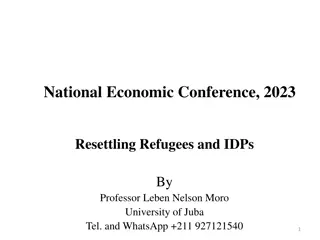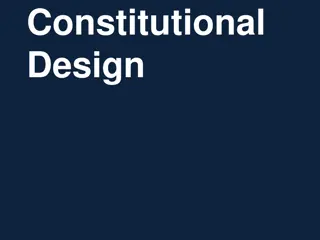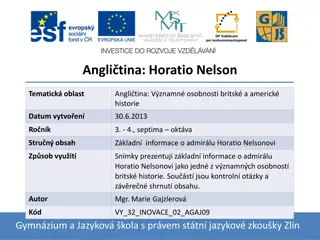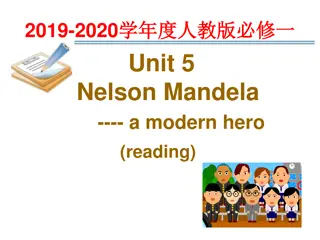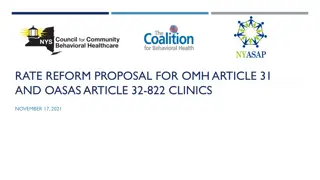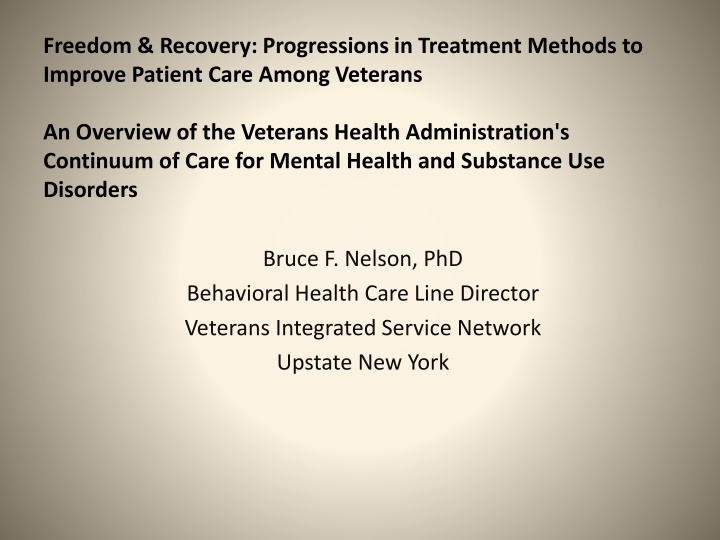
Progressions in Treatment Methods for Veterans' Care: VHA Continuum of Care Overview
Discover the VHA's comprehensive continuum of care for Mental Health and Substance Use Disorders among veterans. Learn about utilization rates, services, and future plans to enhance treatment.
Uploaded on | 1 Views
Download Presentation

Please find below an Image/Link to download the presentation.
The content on the website is provided AS IS for your information and personal use only. It may not be sold, licensed, or shared on other websites without obtaining consent from the author. If you encounter any issues during the download, it is possible that the publisher has removed the file from their server.
You are allowed to download the files provided on this website for personal or commercial use, subject to the condition that they are used lawfully. All files are the property of their respective owners.
The content on the website is provided AS IS for your information and personal use only. It may not be sold, licensed, or shared on other websites without obtaining consent from the author.
E N D
Presentation Transcript
Freedom & Recovery: Progressions in Treatment Methods to Improve Patient Care Among Veterans An Overview of the Veterans Health Administration's Continuum of Care for Mental Health and Substance Use Disorders Bruce F. Nelson, PhD Behavioral Health Care Line Director Veterans Integrated Service Network Upstate New York
Objectives: 1. Provide an overview of the Veterans Health Administration s (VHA) continuum of care for both Mental Health (MH) and Substance Use Disorders (SUD). 2. Share information on the rates of utilization across VHA for both MH conditions and SUD. 3. Provide details regarding the rates of utilization across Substance Abuse Services (SAS) by diagnostic category across the continuum of care. 4. Share updates on VHA s planning and future direction regarding SUD treatment.
Background: Department of Veterans Affairs The Department of Veterans Affairs (VA) was established on March 15, 1989, succeeding the Veterans Administration. It is responsible for providing federal benefits to veterans and their families. Headed by the Secretary of Veterans Affairs, VA is the second-largest of the 15 Cabinet departments and operates nationwide programs for health care, financial assistance and burial benefits. VA employs nearly 345,000 people. 1. Veterans Health Administration (VHA) is America s largest integrated health care system with over 1,700 sites of care. 2. National Cemetery Administration oversees burial benefits, including gravesites at one of 134 national cemeteries. 3. Veterans Benefits Administration provides a variety of benefits and services , such as compensations, pensions, insurance, etc. Information secured from VHA Internet Site
Background: VHA at large 1. VA Hospitals = 144 2. VA Community-based Outpatient Clinics = 819 3. VA Vet Centers = 300 4. VA National Cemeteries = 134 5. Veterans Benefits Administration Regional Offices = 56 Information secured from VHA Internet Site
VHA Global Statistics 1. Veteran population currently alive = 23.4 million. Nearly 75% served during a war or an official period of conflict. Total number of unique users of VHA services = 6.2 million. Total number of unique users of MH services within the larger population of users = 2,011,410. Total number of unique users with an SUD diagnosis = 536,145 (26% of MH users) Office of Policy and Planning projects ~3.9% annual growth in MH workload from FY16 to FY17. 2. 3. 4. 5. Information secured from VHA Performance Evaluation Research Center
VHA Global Statistics 1. Between fiscal years (FY) 2005 and 2015, the number of Veterans who received mental health care from VA grew by 80 percent. This rate of increase is more than three times that seen in the overall number of VA users As yet, it shows no sign of leveling off. The increase in the number of outpatient mental health encounters or treatment visits, from 10.5 million in 2005 to 20.8 million in 2015, has been even more dramatic a 97 percent increase. As a consequence of these trends, the proportion of Veterans served by VA who receive mental health services has shifted substantially. In 2005, 19 percent of VA users received mental health services, and in 2015, the figure was 28 percent. 2. 3. 4. Information secured from VHA Performance Evaluation Research Center
VHAs MH Continuum of Care 1. 2. 3. 4. Primary Care Mental Health Integration. Specialty General Outpatient Mental Health Clinics. Subspecialty PTSD Care Subspecialty SAS (includes: outpatient, intensive outpatient, residential, and acute inpatient for detox services). Vocational Services. Healthcare for Homeless Veterans. Psychosocial Rehabilitation and Recovery Programming for seriously mentally ill patients. Residential Rehabilitation and Treatment Programs (RRTP). a. Population specific, e.g., Substance Abuse RRTP Acute Inpatient MH Units. 5. 6. 7. 8. 9.
Utilization of Services by Diagnosis 1. Patients with mental health diagnoses who received outpatient mental health treatment had, on average, 16 visits during 2015. 2. Patients with diagnoses of depression or PTSD were similar to the overall average in the number of visits and number of visits of each type. 3. Patients with SUD had more mental health visits of all types and more of those visits involved case management, rehabilitation, or supportive services, indicating an overall lower level of functional impairment. Information secured from VHA Office of Mental Health Operations
Total Number of Unique Users with an SUD by Type 1. Total number with an SUD dx = 536,145 a. Alcohol dx = 409,556 b. Amphetamine dx = 25,314 c. Cannabis dx = 114,424 d. Cocaine dx = 78,668 e. OUD = 66,071 Information secured from VHA Performance Evaluation Research Center
Total Number of SUD Visits/Encounters by Program Type 1. SUD Acute Inpatient Services = 15,137 2. SUD Outpatient Services = 151,005 3. OAT Detox = 9,427 4. Primary Care MH Integration = 913,908 5. Therapeutic and Supported Employment = 503,052 6. MH Intensive Case Management = 618,525 7. Psychosocial Rehabilitation & Recovery = 775,077 8. PTSD = 1,594,027 9. Residential Rehabilitation Treatment Programs = 66,071 Information secured from VHA Performance Evaluation Research Center
Evidenced-based Practices 1. Cognitive Processing Therapy and Prolonged Exposure Therapy for PTSD 2. Cognitive Behavioral Therapy, Acceptance and Commitment Therapy, and Interpersonal Psychotherapy for depression 3. Behavioral Family Therapy, Multiple Family Group Therapy, and Social Skills Training for Veterans with serious mental illness 4. Integrative Behavioral Couples Therapy for relationship distress 5. Cognitive Behavioral Therapy, Behavioral Couples Therapy. 6. Motivational Enhancement Therapy, and Contingency Management for substance use disorders 7. Motivational Interviewing to promote motivation and adherence 8. Cognitive Behavioral Therapy for insomnia 9. Cognitive Behavioral Therapy for chronic pain
VA is a Leader in SUD Care In January 2016, VA and DoD published the updated Clinical Practice Guideline for Management of Substance Use Disorders. This guideline was developed using GRADE methodology to systematically evaluate the medical literature on substance use disorder prevention and treatment and includes 36 evidence- based recommendations. http://www.healthquality.va.gov/guidelines/MH/sud/ Information secured from VHA Mental Health Services
VA-DoD Clinical Practice Guideline for Management of Substance Use Disorders 1. 2. 3. 4. Screening Brief Alcohol Intervention Determination of Treatment Setting Treatment (Pharmacotherapy and Psychosocial Interventions)* a. Alcohol use disorder b. Opioid use disorder c. Cannabis use disorder d. Stimulant use disorder 5. Promoting Group Mutual Help Involvement 6. Co-occurring Mental Health Conditions and Psychosocial Problems 7. Follow-up 8. Stabilization and Withdrawal Information secured from VHA Mental Health Services
Opioid Overdose Education and Naloxone Distribution (OEND) 1. Program aims to decrease opioid-related overdose deaths among VA patients by providing education on opioid overdose prevention, recognition of opioid overdose, and training on the rescue response, including provision of naloxone. A harm reduction and risk mitigation approach. 2. Education and training for opioid overdose a. Prevention b. Recognition c. Rescue response (includes prescription for naloxone kits) 3. Championed by several VA Program Offices Information secured from VHA Mental Health Services VA PBM Naloxone Kits RFU, Sept 2014
Treating Alcohol-related conditions in the Primary Care (PC) Setting 1. Progress as been made in expanding our reach for alcohol related conditions across the continuum, incorporates a prevention focus as well. All patients treated in the PC setting receive an annual screening for alcohol use using the AUDIT-C. Benchmarks have been established for having conversations and for referring to sub-specialty SAS. Nevertheless, increasingly, we are treating emerging and subsyndromal conditions in PC using both Care Management protocols and Co-located MH Care Providers. 2. 3. 4. Information secured from VHA Center for Integrated Health Care
Treating Alcohol-related conditions in the Primary Care (PC) Setting 1. The AUDIT-C is a 3 item instrument, scores range from 0 to 12. Clinician is alerted when scores exceed established cut-offs. a. Men greater than or equal to 4. b. Women greater than or equal to 3. Not meant to diagnose, rather to identify those needing further assessment. 2. 3. Information secured from VHA Center for Integrated Health Care
Treating Alcohol-related conditions in the Primary Care (PC) Setting 1. PC is viewed as a logical setting to offer services given the volume of patients seen and its serving as an entry point for those with behavioral problems. Offers an opportunity for early interventions and identification of harmful use patterns. Process incorporates empirically supported screenings, assessments, and interventions. 2. 3. Information secured from VHA Center for Integrated Health Care
Treating Alcohol-related conditions in the Primary Care (PC) Setting 1. Interventions consist of: a. time-limited patient-centered counseling (in person or by phone) focusing on the patient s behavior and increasing compliance. (Fleming, et. al, 1999). b. Provider reviews with participant i. The Drinker s Pyramid. ii. Health risks of drinking. iii. Low-risk drinking and standard drink definitions. iv. Consideration of cutting back or abstaining. Information secured from VHA Center for Integrated Health Care
Treating Alcohol Dependence in the Primary Care (PC) Setting 1. Studies have shown that less than 15% of individuals with alcohol dependence are actively engaged in treatment. Primary Care may be a key component in the identification of such patients and in the delivery of initial treatment. Our studies have demonstrated that PC is a viable alternative to specialty care. It is not a replacement for specialty care but an option for those hesitant to engage in traditional subspecialty services. 2. 3. Information secured from VHA Center for Integrated Health Care



